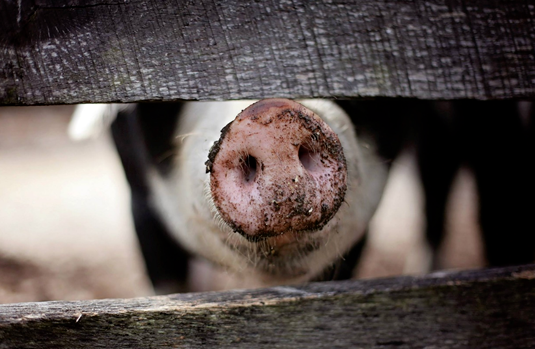RFID improves the digital management level of animal husbandry and brings more protection to people’s livelihood
On August 3, 2018, the first domestic case of African swine fever was diagnosed in Shenyang. Subsequently, African swine fever broke out rapidly in various provinces and cities across the country, which brought a huge impact to the breeding industry and consumer market, and caused serious harm to social production and life.

source:pexels
In fact, before the African swine fever was formally introduced into China, it had already spread wildly in Eurasia, and it has long plagued farmers and the livestock industry. This is mainly because African swine fever is highly contagious, and the fatality rate is as high as 100%, so it is very difficult to deal with. According to relevant studies, there are three main ways for the spread of African swine fever. One is the transfer of live pigs across regions, the second is feeding pigs with food leftovers, and the third is the spread of the virus by people and vehicles. It can be seen that there are many ways of spreading African swine fever, and the work of epidemic prevention and control is very difficult.
Epidemic prevention traceability: the animal husbandry industry comprehensively deploys a traceability system
In recent years, various livestock and poultry diseases represented by African swine fever, avian influenza, mad cow disease, and foot-and-mouth disease have continued to occur, which has brought great challenges to food safety. In the face of frequent food safety issues, the need for food traceability has gradually become a rigid demand, which has become more and more significant in improving the health of residents. China has a vast territory and a large population. Livestock such as pigs, cattle, and sheep often move between multiple provinces and cities. For example, sheep raised in Inner Mongolia are likely to be shipped to all parts of the country. Since Inner Mongolia sheep on the Beijing market are not equipped with ear tags, it is impossible to trace their birth, immunity and other information. Therefore, if the traceability system is to be truly effective, it must be based on a comprehensive layout. In 2006, the National Animal Identification and Disease Traceability System was formally established by the Development and Reform Commission, and 18.19 million yuan was invested to establish a central database. The entire system includes animal ear tag wearing, information entry, file registration, information network system construction, etc., to truly realize animal information can be queried and the source can be traced.
RFID technology is highly compatible with animal husbandry
As the world's most populous country, animal husbandry products occupy an important position in the lives of our nationals. With the continuous improvement of the level of science and technology and the needs of market development, the animal husbandry industry continues to develop in the direction of technology, scale, and efficient management. In this process, the performance advantages of RFID technology in animal husbandry management have become increasingly prominent. At birth, livestock wear RFID ear tags, and the information read is directly connected to the RFID system through the RFID ear tag reader. Through the use of RFID technology, the data system's ability to identify and track animals is greatly improved, and it is suitable for animals in various farms, whether they are raised centrally or dispersed. From traditional livestock farm management to RFID technology management, digital methods have greatly changed the way of animal husbandry. With the help of RFID data collection capabilities, livestock farms can understand the types, epidemics, and numbers of animals in a timely manner, which greatly improves management efficiency and improves the survival rate of animals. Therefore, it has been valued by the farms. In fact, in addition to RFID technology, some farms also try to use QR codes to manage livestock farms. However, practice ultimately proves that RFID technology has a broader application prospect than QR codes. As far as animal husbandry is concerned, although the application cost of QR codes is low, the disadvantages are also very obvious. First of all, from the operating method, the two-dimensional code is optically read, which is greatly affected by light. It is necessary to use positive or negative fill light when the sun's light is insufficient or the light is too strong. The actual operation is very troublesome. Secondly, the reading of the QR code is very affected by the distance, and it can only identify the distance within 15-20 cm. For the livestock that is usually active, this is an insurmountable defect. After all, the pig’s ears are used for identification. The difficulty is not small. The third is the problem of reading time. The two-dimensional code requires about 2 seconds of rest for reading. This is easy to achieve for fixed objects, but it is difficult for livestock. Fourth, when using a two-dimensional code for reading, it is also required that the angle between the reading device and the ear tag should be vertical, and it should not be tilted too much, otherwise normal reading cannot be achieved. Fifth is the problem of wear and tear. In the long-term activities of livestock, it is common for ear tags to be contaminated or worn. For two-dimensional codes, this can easily cause the information to be unreadable.
RFID technology improves the digital management level of animal husbandry
At present, the large-scale domestic farms have turned to digital management, and the maturity of the RFID system application is getting higher and higher. In the past, RFID animal ear tags mostly used low frequency 134.2 kHz, which mainly corresponded to implanted chips and electronic ear tags used in animal husbandry management, including glass tube chips, oxtail tags, external ear tags, and so on. Low-frequency RFID ear tags have high reading accuracy, one-to-one reading and strong anti-interference ability, and are widely used in foreign animal husbandry. In addition to low frequency, the application of UHF RFID ear tags has also increased in recent years. UHF RFID has a long reading distance and can read multiple targets at the same time. However, compared with the low frequency, its anti-interference ability is poor and the misreading rate is high. Therefore, specific frequency bands and solutions need to be selected according to specific scenario requirements. From the perspective of the entire market, the benefits of applying RFID in the animal husbandry industry are manifold. For livestock farms, it can bring benefits in terms of preventing animal diseases, ensuring safe production, and improving the efficiency of animal husbandry management. However, for society, the biggest benefit of RFID lies in the protection of people's livelihood. Take pork as an example. The RFID ear tag of a pig is carried for life. Through this RFID ear tag, it can be traced back to the entire chain of supermarkets where the pig flows from the livestock farm, the purchase farm, the slaughterhouse, and the pork sales. If it is sold to a vendor who processes cooked food, there will also be records. With the identification function of RFID ear tags, a series of participants selling sick and dead pork can be combated, the safety of domestic livestock products can be supervised, and the people can eat healthy pork.

source:pexels

source:pexels
Currently, widely used animal identification methods include ear tags, back tags, necklaces, tail tags, freeze prints, tattoos, lacquer tags, and leg tags. In developed countries such as Europe and the United States, the application of RFID animal husbandry management has been very popular. For example, the British government has long clearly stipulated that all kinds of tracking and identification methods must be adopted for raising animals such as cattle, pigs, sheep, goats, and horses. As the application maturity and popularity of domestic RFID technology in the animal husbandry industry continue to rise, the digital and standardized management level of the animal husbandry industry will also increase rapidly, ultimately benefiting the entire society.






